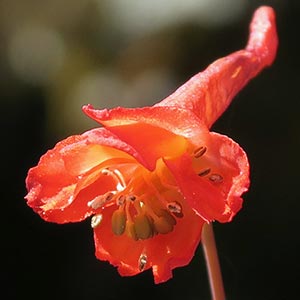Delphinium nudicaule
Delphinium hansenii
canyon delphinium, canyon larkspur, orange larkspur, red larkspur, red or orange larkspur, scarlet larkspur
Eldorado larkspur, Hansen's delphinium, Hansen's larkspur
(15-)20-50(-125) cm;
base reddish, glabrous.
(25-)40-80(-180) cm;
base usually reddish, pubescent.
blade round to pentagonal, 2-6 × 3-10 cm; ultimate lobes 3-12, width 5-40 mm (basal), 2-20 mm (cauline).
blade pentagonal, 1.5-5 × 2.5-8 cm, long-pubescent, especially abaxially; ultimate lobes 0-18, width 4-20 mm (basal), 2-9 mm (cauline).
5-20(-69)-flowered;
pedicel (1.5-)2-6(-8) cm, glabrous to glandular-pubescent;
bracteoles 14-20(-30) mm from flowers, green to red, linear, 2-4(-9) mm, glabrous to puberulent.
(9-)15-40(-160)-flowered, dense to open;
pedicel 0.3-2.5(-6) cm, puberulent;
bracteoles 1-5(-8) mm from flowers, green, sometimes white-margined, linear-lanceolate, 2-6(-8) mm, puberulent.
sepals scarlet to reddish orange, rarely dull yellow, glabrous, lateral sepals forward-pointing to form pseudotube, (6-)8-13(-16) × 3-6 mm, spurs straight, slightly ascending, (12-)18-27(-34) mm;
lower petal blades elevated, exposing stamens, 2-3 mm, clefts 0.5-1 mm;
hairs sparse, evenly dispersed, yellow.
sepals violet to white, ± puberulent, lateral sepals spreading to forward pointing, 7-10(-13) × 3-6(-8) mm, spurs gently upcurved, ascending 0-30° above horizontal, (6-)9-13(-16) mm;
lower petal blades elevated, ± exposing stamens, 3-7 mm, cleft 1-2(-4) mm;
hairs centered, densest on inner lobes near base of cleft, white.
13-26 mm, 3.5-4.5 times longer than wide, glabrous.
8-20 mm, 2.2-4 times longer than wide, glabrous.
unwinged or sometimes slightly wing-margined;
seed coat cells with surfaces smooth.
echinate, appearing fuzzy to naked eye;
seed coat cells with margins straight, surfaces sparsely pustulate.
= 16.
Delphinium nudicaule
Delphinium hansenii
Delphinium nudicaule hybridizes with most other taxa of Delphinium that it encounters. Apparent hybrids involving D. nudicaule, and seen by the author (either afield or as specimens), include D. andersonii, D. antoninum, D. decorum, D. luteum, D. nuttallianum, D. patens, and D. trolliifolium. In addition, garden-grown plants have been hybridized with D. cardinale, D. elatum, D. menziesii, D. parishii, D. penardii, D. tatsienense Franchet, D. triste Fischer ex de Candolle, and D. uliginosum; D. nudicaule does not naturally occur with these species. Delphinium nudicaule is one of the earliest larkspurs to flower in any given locality. Douglas's type collection of D. nudicaule represents plants (synonyms D. sarcophyllum Hooker & Arnott and D. peltatum Hooker, an invalid name) grown under very moist conditions, probably quite near the ocean. The type specimen of D. armeniacum A. Heller represents plants grown under unusually dry conditions.
The Mendocino Indians consider Delphinium nudicaule a narcotic (D. E. Moerman 1986).
(Discussion copyrighted by Flora of North America; reprinted with permission.)
Subspecies 3 (3 in the flora).
Although Delphinium hansenii has often been confused with D. hesperium, seeds will instantly allow identification. Seeds of Delphinium hansenii are, as far as known, unique, bearing numerous, elongate, prismlike raised structures (extensions of single cells or small groups of cells) over the entire seed coat. If seeds are absent, larger flowers, more open inflorescences (except in D. hesperium subsp. cuyamacae), and general absence of pubescence of long hairs in D. hesperium are apparent upon comparison of the two species. Separating D. hansenii from D. variegatum may also be difficult. Again, seeds leave no doubt. In addition, smaller flowers and greater number of flowers per plant of D. hansenii should serve to distinguish D. hansenii from D. variegatum. White-flowered D. hansenii has been confused with D. gypsophilum and with D. hesperium subsp. pallescens. Other than seeds, pubescence of long hairs and smaller flowers present in D. hansenii and absent in the others will distinguish them.
(Discussion copyrighted by Flora of North America; reprinted with permission.)
1. Sepals reddish purple to dark maroon. | subsp. ewanianum |
1. Sepals dark blue-purple to white. | → 2 |
2. Leaves primarily basal (although leaves may be dry at anthesis and thus lost in herbarium specimens, petiole base will be present); cauline leaves usually fewer than 3; sepals bright blue to white. | subsp. kernense |
2. Leaves primarily cauline, basal leaves usually absent at anthesis; cauline leaves 3 or more; sepals dark blue-purple to white or pink. | subsp. hansenii |


